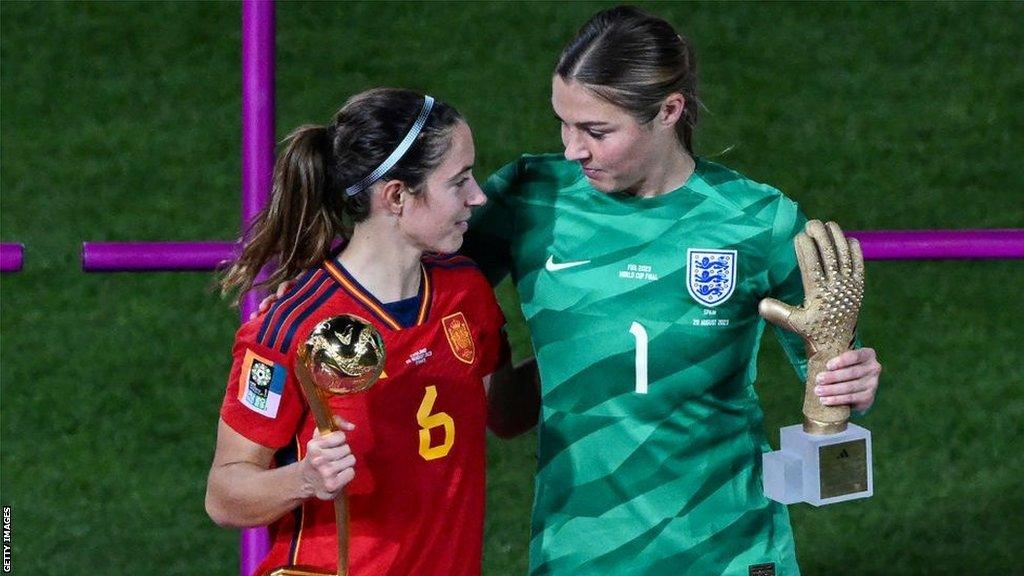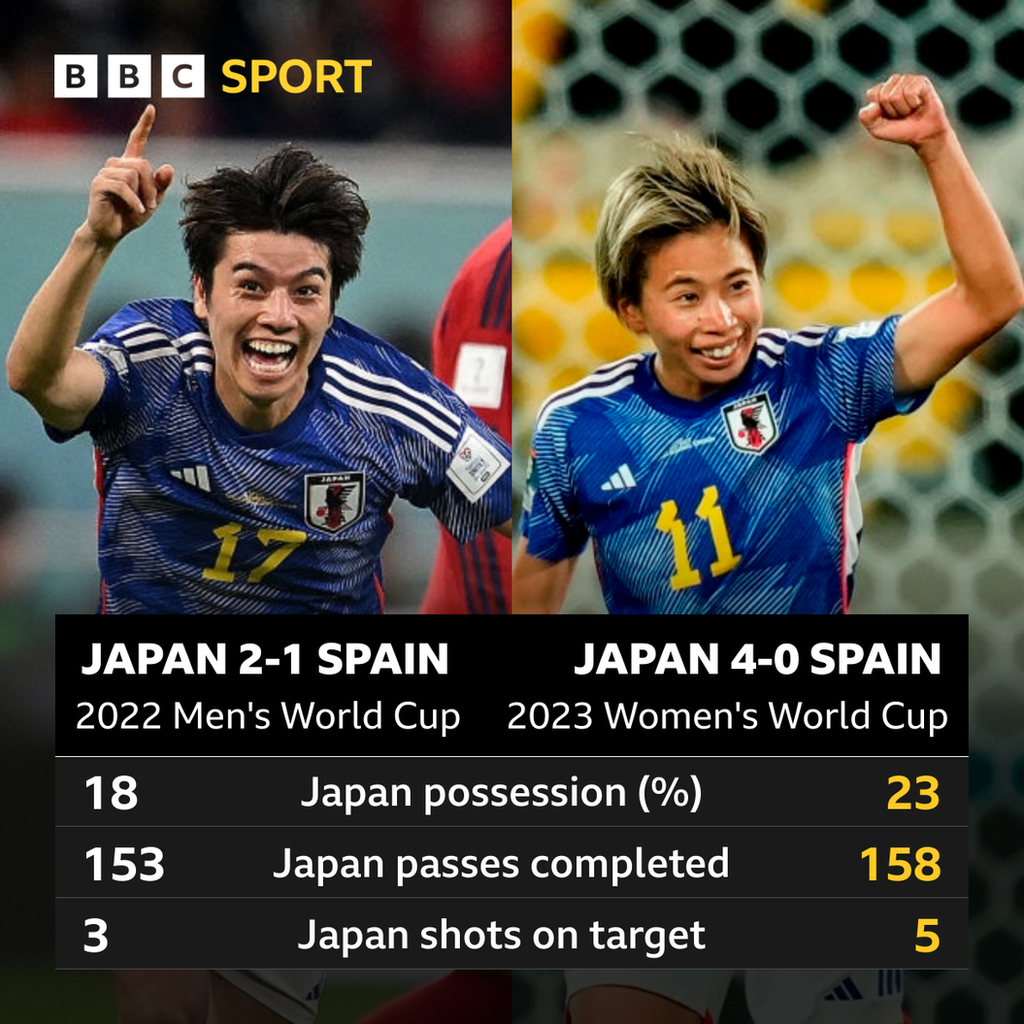Women's World Cup 2023: What the stats say about the tournament
- Published
Women's World Cup 2023: Spain defeat England to win the Women's World Cup 2023
One month, 64 games, and 164 goals later - a new record total in a single edition of the tournament - it was Spain who lifted the Women's World Cup in Sydney.
Sunday's showpiece between Spain and England involved two sides breaking new ground at international level.
Prior to this edition, eight nations had reached a Women's World Cup final, yet Spain and England were not among them. Indeed, La Roja had never even won a game in the knockout stages of the World Cup before this tournament.
Spain's eventual 1-0 win - courtesy of a first-half strike from Olga Carmona - was the fine margin by which two of women's football's most ascendant teams were separated, as England suffered their first competitive defeat under Sarina Wiegman.
No mistaking Spain's champion class
Spain were deserved winners on the balance of play in the final though, out-performing England in terms of shots (13), expected goals (2.2) and touches in the penalty area (31), as well as having the favourable share of possession (57%).
In fact, it was the first time all tournament England had less possession than their opponents, and that was a common thread between the two finalists.
Women's World Cup: Sarina Wiegman proud of England after defeat against Spain in final
Before Sunday's game, Spain (71%) and England (66%) were the two sides involved in the knockout stages with the highest possession average.
According to Opta's sequence data, they were also the two teams leading into the final who averaged the most passes per open play sequence (3.9 for England, 3.6 for Spain) - highlighting their patient approaches in possession.
When the two forces met, however, La Roja showed they had the upper hand.
Much like the men's team who won the 2010 World Cup, Spain's starting XI featured a raft of Barcelona players from whom the connections flowed, and they did so from one player in particular - Golden Ball winner Aitana Bonmati.
The 25-year-old is a symbolic figure for club and country, especially in terms of identity and how both teams look to play.
At this World Cup, Bonmati had the best pass completion rate in the opposition half of any midfielder (86%), with her quality on the ball ensuring Spain's passages of play flowed without issue.
But it was not just her efficiency as a passer that secured her the Golden Ball. Bonmati combined her security on the ball with passes that changed the landscape of the game; the type that picked holes in the opposition's defensive shape.
Of the 44 line-breaking passes she made in the tournament, 15 of those broke the opponent's defensive line - no player had more.

Living in a Paralluelo universe
Bonmati was not the only Spain player to scoop an individual award after the final.
Salma Paralluelo - who became just the fifth teenager to start in a Women's World Cup final - was named as the best young player, after a tournament in which she provided the spark to go with La Roja's craft.
The 19-year-old netted important goals in both the last eight and semi-final after coming off the bench - and made an outstanding overall impact through her dynamism in the final third.
Paralluelo made more successful take-ons (22) than any other player in the tournament, while Australia's Caitlin Foord (26) was the only winger who made more long progressive carries than the Spanish teenager (23).
Golden age of Earps
England fell short on the night, but the individual awards were not exclusive to the winning side. Mary Earps was named as the best goalkeeper of the tournament with the Golden Glove accolade.
The England number one saved a penalty from Jenni Hermoso in the final, in what was the fifth penalty save of the tournament overall (excluding shootouts), and the only one saved in the knockout stages.
Overall, only Australia's Mackenzie Arnold (four) kept more clean sheets than Earps (three) in the tournament.

Spain's Aitana Bonmati with her Golden Ball trophy and England goalkeeper Mary Earps with her Golden Glove
And according to Opta's expected goals on target model - which measures how many goals a goalkeeper concedes from the quality of shots on target faced - Earps prevented the third-most goals of any goalkeeper in the tournament (+2.7), only behind Colombia's Catalina Perez (+3.6) and Jamaica's Rebecca Spencer (+2.8).
The tournament may have belonged to the queens of possession, who thoroughly deserved their trophy, but this was not an edition in which Spain had it entirely their own way.
Women's World Cup 2023: Japan stride to last 16 after 4-0 Spain dismantlement - highlights
The most stunning result of the tournament was, ironically, one inflicted over the eventual winners.
Japan's 4-0 victory against Spain in the group stage wasn't notable just for the scoreline, but rather for the way in which it was done. Futoshi Ikeda's side, in spite of the convincing victory, achieved it on the back of a remarkable 23% possession.
Indeed, for anyone who watched that game with a strong feeling of deja vu, then there was good reason for it.
Opta's historical data shows Japan now hold the record at both the women's and men's World Cup for the victories with the lowest possession - and both of those wins came against Spain (in the 2022 men's World Cup and this one).
Of course, Spain rebounded impressively from that defeat to go on and lift the trophy. In doing so, they became only the second side to be crowned champions of the Women's World Cup after losing in the group stage, following Japan in 2011.

Spain were one of the pre-tournament favourites who lived up to the billing, but along the way there were a number of sides who left earlier than expected.
Four-time winners the United States were knocked out in the last 16 by Sweden, in what was the earliest they have ever exited an edition of the Women's World Cup.
Meanwhile, the only other team to have lifted the trophy on more than one occasion - two-time winners Germany - were eliminated in the group stage for the first time.
Another surprise exit from the group stage saw Brazil bow out, failing to qualify for the knockout stages for the first time since 1995.
For others, the 2023 group stage will be remembered as a landmark moment, and a source through which they can aspire to more in future tournaments.
African teams on the rise
With South Africa and Morocco qualifying for the knockout stages of the World Cup for the first time, along with Nigeria, it was the first time three African sides advanced from the group stage.
After Europe, who had eight different nations reach the knockout stage, Africa was the next best represented continent through those three.
While an urge to get even may drive some World Cup teams that fell short this year, others will look towards 2027 with a growing sense of hope.
And England? The goal will be clear. They'll be looking to emulate Norway in 1995 and USA in 2015 as the teams who won the Women's World Cup after finishing as runners-up in the previous tournament.
Once the pain of final defeat fades, the Lionesses can set their sights on 2027 with plenty of optimism.